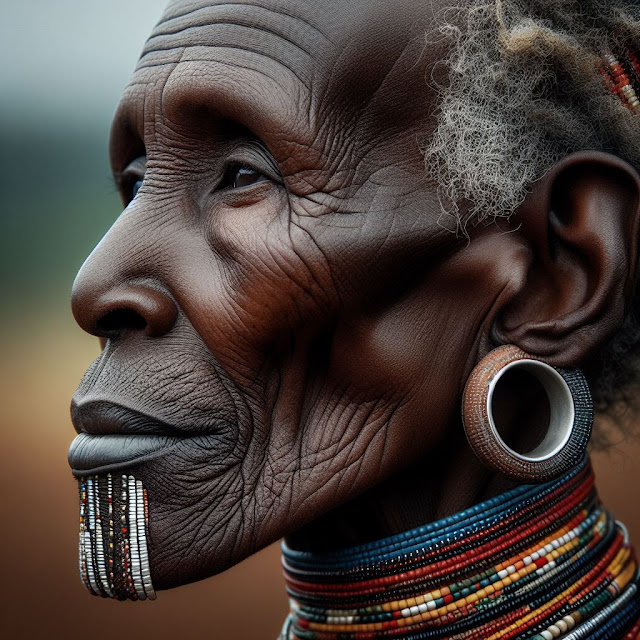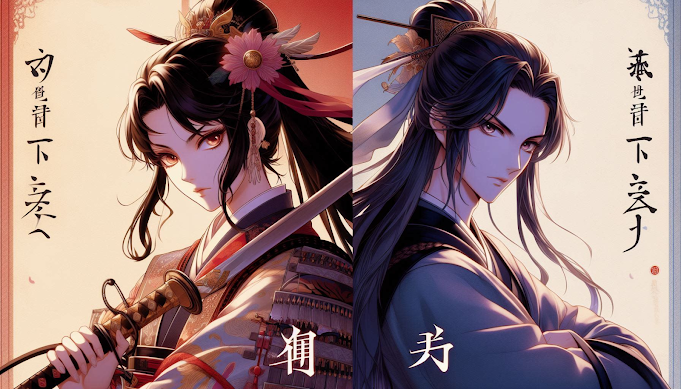The dawn, a symphony of golds and oranges, painted the Omo Valley as Esete, adorned in the rising sun's hues, surveyed her land. Her crimson toga, draped like a warrior's cloak, flowed behind her as she strode, her mahogany skin gleaming with ochre. Brass earrings, wide as moons, grazed her shoulders, a counterpoint to the intricate scars that mapped her life story across her chest. Esete was a Suri woman, and wisdom, like the lines on her face, etched her very being.
The Suri were a people forged in the harsh beauty of the Omo Valley. Semi-nomadic cattle herders, their lives revolved around their herds and the whims of the Omo River. But within this seemingly rugged existence bloomed a society where women held the reins. The Suri women, like Esete, were crowned with regality.
Their attire was a vibrant tapestry of their culture. Skirts of intricately dyed goatskin, each fold a story whispered in ochre and clay, swished with their every step. Tobogas, handwoven from crimson cotton, were worn like shawls, their rich folds framing strong, calloused hands. Brass adorned them - heavy earrings, weighty necklaces, and broad anklets that sang a rhythm against the parched earth. These weren't mere ornaments; they were a declaration of a woman's worth, a measure of the cattle her family possessed, a testament to her resilience.
But true beauty, the Suri knew, resided not in adornment but in the unyielding spirit that shone from a woman's eyes. Theirs was a life etched in hardship. Childbirth, under the vast African sky, was a rite of passage. They bore the brunt of the backbreaking labor, fetching water, gathering herbs, and tending to the intricate beadwork that adorned their homes. Yet, they moved with a quiet grace, their laughter echoing through the settlements, a melody woven into the hum of daily life.
Esete, like all Suri women, was a warrior in her own right. She wielded a whip that could snap a hyena's jaw and a knowledge of herbs that rivaled any shaman. She led the women in the sacred cattle dances, their rhythmic stomping a testament to their unwavering spirit. More importantly, she was the keeper of traditions, the weaver of stories that bound generations together.
Evenings were a symphony of storytelling. Esete, seated around a crackling fire, would weave tales of creation, of cunning heroes, and of ancestors who walked under the same star-studded sky. Her voice, seasoned with age and wisdom, would transport the young girls, their eyes wide with wonder, to a world where the boundaries between myth and reality blurred. In these stories, they learned the importance of courage, the value of community, and the unwavering strength that resided within them.
The Suri men, fierce warriors themselves, respected the women as their equals. Decisions were made in a council where women's voices held equal weight. They were the custodians of the herd's health, the shrewd negotiators in cattle trades, and the backbone of the Suri economy. A woman's worth wasn't just measured in cattle; it was the bedrock upon which the entire community thrived.
As the sun dipped below the horizon, painting the sky in fiery hues, Esete watched the young girls practicing their dance steps, their laughter echoing in the twilight. A satisfied smile touched her lips. The legacy of the Suri women, the legacy she carried, was secure. These girls, adorned not just in brass but in the wisdom of generations, would one day become the wise women, the beating hearts of the Suri tribe.
~Frankinscience
Honor the Strength of the Suri Women: Explore Artwork Inspired by Esete's Story. ✨
Art by Carlos G. Maier
Carlos G started taking pictures in Germany with nothing more than a Kodak Instamatic camera and curiosity. He completed a three-year photography apprenticeship and later earned a bachelor degree in marketing communication and design. He then headed to the US to join an elusive club of mad men.


.jpg)
.jpg)
.jpg)


Comments
Post a Comment